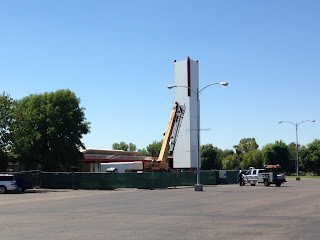If
you happen to be familiar with the nursery rhyme “Here’s the Church” then you
may have asked yourself at one point or another, “what’s a steeple?” If you’re
not familiar with the nursery rhyme it goes like this:
“Here
is the church the church, here is the steeple
Open
the doors and see all the people.
Here
is the parson going upstairs,
And
here he is saying his prayers.”
There
are hand movements that go along with it, kind of like Miss Mary Mack. Anyhow
back to the steeple, what’s its point? According to David England of the Religious Product News, “The vertical lines of the steeple helped
to visually enhance the lines of the church, directing the viewers' eyes
vertically to the heavens.”
So
if a church is going to use the architectural influences of the 1700s, then why
not update it with technology from the 21st century? It seems rather
efficient. However, some residents of Phoenix, Arizona believe a cell tower disguised
as a church steeple is an eyesore and the President of the North Central
Phoenix Homeowner’s Association Mary Crozier even said, “"Unfortunately, it doesn't serve any
religious purpose other than to line the pockets of the lease holder.”
(Source: KPHO)
While some may believe this to be true, steeples
have been around since the 18th century when King George I ascended
the throne. “This verticality
complements part of the mission of the church, to keep us in a heavenly frame
of mind, but from an architectural standpoint, this vertical lift gives the
architecture a more graceful and pleasing look,” England explains.
The 1996 Telecommunications Act took down
unnecessary regulatory barriers to entry, such as governments denying the
placement of cell phone towers for aesthetic or potential health reasons. A
U.S. district judge also recently ruled that the city of Phoenix has no say
regarding the construction of church steeples or what is inside them. Crossroads
Church is in the process of constructing their steeple with a cell tower
inside. The city’s legal department is going over the ruling to see if they can
appeal or try to change zoning ordinances.


No comments:
Post a Comment